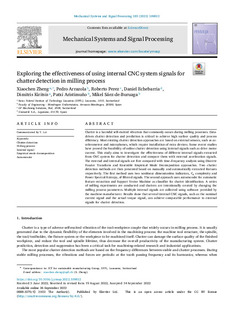Título
Exploring the effectiveness of using internal CNC system signals for chatter detection in milling processFecha de publicación
2023Otras instituciones
Swiss Federal Institute of Technology LausanneGF Machining Solutions
Unimetrik
Versión
Version publicadaTipo de documento
ArtículoArtículoIdioma
InglésDerechos
© 2023 The AuthorsAcceso
Acceso abiertoVersión de la editorial
https://doi.org/10.1016/j.ymssp.2022.109812Publicado en
Mechanical Systems and Signal Processing Vol. 185. Artículo 109812Editorial
ElsevierPalabras clave
Chatter detection
Milling process
Internal signal
Empirical mode decomposition ... [+]
Milling process
Internal signal
Empirical mode decomposition ... [+]
Chatter detection
Milling process
Internal signal
Empirical mode decomposition
Autoencoder [-]
Milling process
Internal signal
Empirical mode decomposition
Autoencoder [-]
Resumen
Chatter is a harmful self-excited vibration that commonly occurs during milling processes. Data-driven chatter detection and prediction is critical to achieve high surface quality and process efficien ... [+]
Chatter is a harmful self-excited vibration that commonly occurs during milling processes. Data-driven chatter detection and prediction is critical to achieve high surface quality and process efficiency. Most existing chatter detection approaches are based on external sensors, such as accelerometers and microphones, which require installation of extra devices. Some recent studies have proved the feasibility of online chatter detection using internal signals such as drive motor current. This study aims to investigate the effectiveness of different internal signals extracted from CNC system for chatter detection and compare them with external acceleration signals. The external and internal signals are first compared with time–frequency analysis using Discrete Fourier Transform and Ensemble Empirical Mode Decomposition approaches. Two chatter detection methods are then presented based on manually and automatically extracted features respectively. The first method uses two nonlinear dimensionless indicators, C0 complexity and Power Spectral Entropy, of filtered signals. The second approach uses autoencoder for automatic feature extraction and Support Vector Machine as classifier for chatter identification. A series of milling experiments are conducted and chatters are intentionally created by changing the milling process parameters. Multiple internal signals are collected using software provided by the machine manufacturer. Results show that several internal CNC signals, such as the nominal current signal and the actual torque signal, can achieve comparable performance to external signals for chatter detection. [-]
Colecciones
- Artículos - Ingeniería [763]
El ítem tiene asociados los siguientes ficheros de licencia:






















